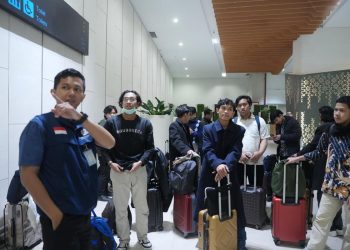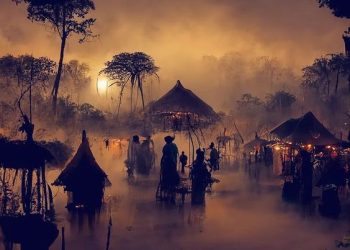Talking about the charm of Papua, it seems endless. The island is 785,753 square kilometers or the second largest in the world. Its natural beauty, biodiversity and culture are always interesting to talk about.
The charm of the underwater world, the coastline, the mountains, and the eternal snow are some of the legendary stories of Papua, which have become a magnet among domestic and world tourists. In fact, there are many more beautiful charms of Papua that are interesting to explore.
One of them is the Kali Biru natural tourist attraction in Raja Ampat Regency, Southwest Papua Province. It is located in Warsambin Village, Teluk Mayalibit District, about 50 minutes by road from Waisai, the district capital.
Kali Biru is a small river in the middle of the Warsambin forest that springs from the surrounding mountains. Warsambin itself is one of 12 villages from the Teluk Mayalibit District.
The 50-minute drive from Waisai to Warsambin passes on smooth asphalt through the dense green wilderness of the district forest. In the afternoon, this route will be pitch dark because the road is not equipped with lighting.
Along the way after the city limits, we will rarely find villages. Therefore, it is recommended to travel to Warsambin and then to Kali Biru in the morning and return to the city before dusk.
In fact, Kali Biru is outside of Warsambin Village and must be reached using a motorized boat or speedboat. Therefore, when arriving at the village on the coast of the bay, we must immediately rent a speedboat with a capacity of 10-12 people. The price is IDR 500,000 for a round trip with a maximum rental time of five hours or before 15.00 WIT.
We also have to hire a guide from Warsambin residents at a cost of IDR 100,000 and an entrance ticket of IDR 50,000 per person. Usually, the guides at the location are children aged between 13-15 years old who already know the route to the location very well.
Meanwhile, boat owners usually do not want to be guides because they have to look after the boat. The journey from the jetty to the boat docking point in the middle of the forest is about 20 minutes. Along the way to Kali Biru, we will be treated to a beautiful view of the green forest among the Waigeo group, the largest island in Raja Ampat where Warsambin and Kali Biru are located.
The water surface around the island cluster is so clear that we can see with the naked eye natural coral reefs and hundreds of species of fish of various shapes under our boat. After 10 minutes, the boat turns left and immediately enters the mouth of a river with clear water and a fairly strong current. Again, the dense green forest on either side of the river lulls the eye with the chirping of various birds.
Big tall trees rise up, as if to greet the arrival of anyone who enters the river. Before long, the boat pulls over on a rocky land with a sign that reads “Sapta Pesona”. This is the last stage of the journey to Kali Biru. A dirt path must be walked for about 20 minutes before meeting a shallow river as high as an adult’s ankle.
The water looks clear and very cold, although the air temperature around is no more than 25 degrees Celsius. The sound of forest insects also entertains the footsteps. After crossing the shallow stream for five minutes, our feet will hit the cement stairs on which there is a wooden gate that reads “Welcome to Kali Biru”.
Hang on, because we still have to tread a cement-clad path for 200 meters, followed by a slatted boardwalk for 100 meters and ending at the edge of Kali Biru. As the name suggests, this small river has very clear blue water and sometimes turns turquoise green. It is so clear that our eyes can freely see the riverbed in the form of rocks, dead logs, and of course various fish.
The current of the river is not swift, in fact it tends to be calm. Large, tall trees seem to hug the nature around the river tightly and make the sunlight only penetrate in a few parts. The width of the river is about 2 meters although in some corners it can reach 4 meters. Likewise, the depth is around 2-3 meters, although some reach 5 meters.
When swimming in this Kali Biru, our body skin can feel the river water so cold, around 15-20 degrees Celsius. The preservation of the Warsambin forest is another reason why the river water feels very cool. Despite being in the middle of the wilderness, the Kali Biru area has been organized because there are several lodges or gazebos for visitors to sit around and toilets.
The local community jointly maintains the cleanliness of the Kali Biru environment. Visitors are asked not to leave the garbage they produce. Assisted by the guide, visitors must bring back plastic waste, food wrappers, and others out of Kali Biru and disposed of in a special place around the Warsambin pier.
In a number of impressions on the Youtube social media platform, we can see that visitors to Kali Biru are not only dominated by domestic tourists. Because a number of foreign tourists also enjoy and swim in the clarity of the river which has several greetings by the local community, such as Waiyal or “hope water” and Warabiar or “clear water”.
Head of Raja Ampat Tourism Office Yusdi Lamatenggo, as quoted from Antara, said that Kali Biru, which has been open to the public since 2016, is one of the district’s mainstay tourist attractions. “Every tourist visit to Kali Biru can help the local economy, especially boat transportation service providers and local guides. So do the owners of food and drink stalls there,” he said.
A tourist from Jakarta named Ranny stated that Kali Biru is the best river destination ever in the country because its beauty is also supported by natural beauty that is still very well preserved. Before exploring Kali Biru, don’t forget to prepare funds as needed and enough food and drink supplies because there are no stalls in Kali Biru.
Then, prepare casual clothes such as long-sleeved T-shirts, cotton pants or cargo pants including a change of clothes and it is advisable to wear mountain sandals instead of shoes. Try to wear a hat and apply anti-mosquito cream and sunscreen. Don’t forget to prepare a large plastic bag to collect waste from eating and drinking to be brought back out of tourist destinations so that the cleanliness and sustainability of the Kali Biru area and its surroundings are maintained. Happy traveling! (Indonesia.go.id)


























